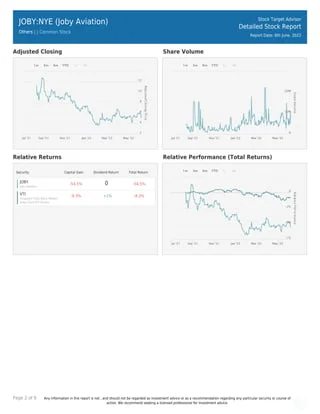For decades, we’ve looked to the sky and dreamed. We’ve read the science fiction, watched the films, and sketched our own visions of a future where transportation wasn't bound by the asphalt grid below. It was a beautiful, persistent dream of silent, electric vehicles whisking us over the city, turning traffic jams into a distant memory. For most of my life, that dream has remained just over the horizon. But I’m writing to you today to say that the horizon is finally here. We are standing at the threshold of a new age in mobility, and the company kicking the door open is Joby Aviation.
What we’re witnessing with Joby isn’t just another tech startup with a flashy prototype. This is the painstaking, methodical, and now rapidly accelerating process of turning a foundational dream into a certified, manufactured, and operational reality. When I first saw the footage of Joby’s aircraft banking silently over the California coastline, I honestly just sat back in my chair, speechless. It wasn't the technology that struck me—we’ve seen concepts for years. It was the quiet confidence of the machine. It looked less like an experiment and more like an inevitability.
This isn't a computer rendering anymore. This is a real, conforming airframe being assembled. It’s pilots—first Joby’s, then the FAA’s—climbing into the cockpit for certification flights. It’s public demonstrations not just in a California hangar, but in the skies over Japan and Dubai, proving the platform on a global stage. The company has reached Stage 5 of the FAA’s type certification process, a milestone that separates the serious players from the pretenders. This is the kind of breakthrough that reminds me why I got into this field in the first place—to see the very architecture of our daily lives be rewritten for the better.
The Fuel for the Final Mile
Of course, turning a revolution into a business requires more than just engineering brilliance; it requires capital. And that’s why Joby’s recent announcement—Joby Aviation Launches Underwritten Offering of Common Stock—is perhaps the most telling signal of all.
Now, when a pre-revenue company announces a massive capital raise, the cynics immediately sharpen their knives. They see dilution, they see cash burn, they see risk. Wall Street is a creature of habit, and its models are built on historical data. Analysts have a consensus “Hold” rating on JOBY stock, with an average price target that implies a steep drop from its current highs. They look at the -71% return on equity and the lack of profitability, and they see a static picture: a company spending money it doesn’t yet make.
But they are committing the classic error of trying to measure a rocket ship with a yardstick.
This $500 million isn't a lifeline; it’s high-octane fuel for the final leg of the race. They're raising this money through an underwritten offering—in simpler terms, they’re selling new shares with the full backing of a giant like Morgan Stanley to fund the last critical steps: scaling manufacturing, finalizing certification, and preparing for the first commercial flights. This isn't a move born from desperation. It’s a calculated, strategic strike to ensure they have an overflowing war chest as they transition from development to deployment.

The skeptics see a pre-revenue company and get nervous, but they're missing the entire point—this isn't about next quarter's earnings, it's about building the infrastructure for the next century of movement, and that requires a kind of conviction that doesn't fit neatly into a spreadsheet. The high short interest in the stock, hovering around 11%, tells the same story. A significant number of traders are betting against Joby, focusing on today's balance sheet instead of tomorrow's skyline. They’re like the chess player Veselin Topalov in his legendary 1999 match against Garry Kasparov, watching his opponent sacrifice a powerful rook and seeing only the immediate loss, completely blind to the brilliant, game-winning attack it set in motion.
What does this moment of friction—this tension between the visionaries and the accountants—really tell us? It proves that we’re at the precipice of something truly disruptive. True innovation is always met with skepticism. It’s a law of nature.
Building the New Grid
This isn’t just about a single aircraft. Joby is assembling the entire ecosystem. Their acquisition of Blade Air Mobility’s passenger business isn't a small side deal; it’s a strategic masterstroke to secure landing infrastructure and operational know-how in key markets like New York City. Their partnership with Toyota isn’t just for funding; it’s about tapping into a century of manufacturing excellence to scale production from a handful of prototypes to a fleet of 500 aircraft per year at their new Ohio facility.
They are building a dual-track strategy, targeting not just commercial ride-sharing but also military applications with a hybrid-electric model developed with L3Harris. This is the playbook of the aerospace giants—diversify, integrate, and become indispensable.
We’re not just watching a company build a product. We’re watching the birth of a new transportation grid, laid directly over the top of our existing cities. Think about that for a second. What happens to real estate values when a commute from the suburbs to downtown shrinks from 90 minutes to 15? How do our cities evolve when the radius of practical travel expands by a factor of five or ten?
This brings us to our own responsibility in this new chapter. As we build this new layer of mobility, we have to ask ourselves how we can ensure it’s deployed equitably and safely. How do we make this a tool that connects communities, rather than one that just serves the elite? The technology is breathtaking, but its ultimate value will be measured by how it serves humanity. This is our moment to get it right from the start.
We're No Longer Waiting for the Future
For so long, the future of transportation has felt like a distant promise. It was something we’d get to eventually. But the evidence is now overwhelming. The stock offering is the final funding round. The certification process is in its endgame. The factories are being built. The public flights are happening.
The skeptics will continue to stare at their spreadsheets, but the rest of us should be looking up at the sky. What Joby is doing is far more than a financial play or an engineering challenge. It’s the physical manifestation of a dream we’ve all shared. They’re not just selling stock; they’re offering us all a seat for the inaugural flight into the next era. And it’s preparing for takeoff right now.









